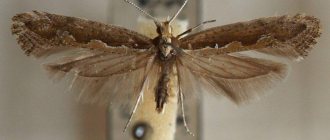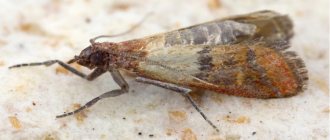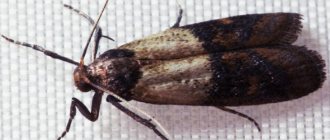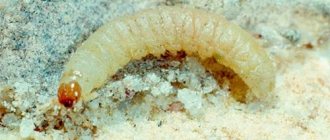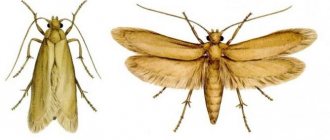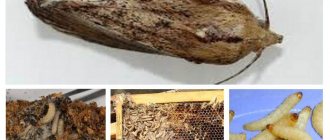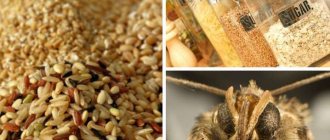food moth – an insect that appears in the kitchen and infects bulk products:
- Cereals.
- Legumes.
- Nuts.
- Dried fruits.
- Dry food for animals.
- Cereals, etc.
It is difficult to fight this parasite, but there are still ways to clean the premises from the pest.
food moth
First of all, you need to know what this pest looks like:
- This is a small butterfly, up to 1 cm in size,
- The butterfly is gray or brown with a pearlescent tint and patterns on the wings in the form of stripes or dots.
- Thanks to this color, it is difficult to notice on food products.
- It moves through the air chaotically, constantly changing direction.
- Moth larvae are small translucent white worms with a dark head.
- Most often this insect can be seen in the evening; it is active at night. During the day - sits motionless on walls, furniture or other objects in the kitchen.
Type and lifespan
Name: Food moth Lat.:
Sitotroga cerealellaClass: Insects - Insecta Order: Lepidoptera - Lepidoptera Family: Lepidoptera - Gelechiidae
| Habitats: | kitchen cabinets |
| Dangerous for: | groceries, fruit |
| Means of destruction: | chemicals, folk remedies |
Food moth caterpillar.
Many people know what food moth looks like. Most often, so-called flour moths appear in the kitchen. It looks like a small butterfly, reaches up to 10 mm in length, its color is discreet, its wings have a silvery coating, and the caterpillar is pink or light yellow.
Ideal conditions for development are +20-25 degrees and humidity 50%. All stages of development from egg laying to the appearance of the moth take about 1.5 months.
Signs of appearance
The pest may not be immediately noticed; it camouflages itself very well. But some characteristic signs of the appearance of moths are still present from the first days, and subsequently they become more and more noticeable:
- Small gray-brown butterflies appeared chaotically flying in the kitchen and adjacent rooms. At first these are isolated cases, but if measures are not taken, they become more numerous. In addition to flying through the air, they can also be seen in bulk products, where they climb to lay eggs. They are clearly visible in light-colored flour and cereals.
- Inside kitchen cabinets, in corners, cracks, and sometimes just on the wall, small transparent white worms with a dark head - moth larvae - crawl. They can also be seen in food containers.
- In cereals or other similar products, cobwebs or small lumps of grains, dust and cobwebs with a worm inside have appeared - cocoons from which an adult individual emerges.
If at least one of these signs is noticed, it is necessary to act immediately, without waiting for the time when all the supplies in the kitchen are infected with this parasite.
What does it eat and what is it afraid of?
Traces of moth activity.
The moth feeds in the kitchen on flour, cereals, bran, pasta, dried fruits, nuts, and dried mushrooms. You can notice it by the grains stuck together, somewhat similar to a cobweb.
Plastic bags are not a hindrance for moth larvae; they easily gnaw holes in them and easily migrate from one bag to another if they lack food.
Butterflies cannot tolerate specific odors, for example, fresh orange peels, garlic cloves, bay leaves, lavender, mint, tansy. But these methods are only applicable against butterflies; aromas do not affect the larvae and eggs.
To destroy food pest larvae, there are household chemicals.
Harm from food moths
The moth itself is not dangerous to humans. But still, its existence in the kitchen does a lot of harm:
- Flying through the air, adult individuals can get into prepared food that is on the table, contaminating it and making it unfit for consumption.
- Moth larvae, when multiplying, spoil all bulk products in the kitchen, contaminating them with waste products and shell residues, which must then be thrown away.
- In addition, by crawling on kitchen utensils and dishes, worms can spread infection. Eating foods contaminated with moths can lead to unpleasant or even serious consequences:
- Cause allergies.
- Lead to indigestion.
- Intoxication.
- Decreased immunity.
- The presence of a pest in the kitchen causes psychological discomfort. Moths flying through the air, worms crawling everywhere, thoughts that there could be parasites in the products from which the food is prepared can unbalance even the most mentally stable person.
Reasons for appearance
It is a mistaken belief that moths are caused by a sloppy housewife. This does not depend on cleanliness; insects can appear even in the most sterile kitchen. It cannot start on its own, but gets into the apartment in a certain way.
Let's consider the reasons for the appearance of a pest in an apartment:
- Most often, the insect is brought into the house along with purchases. When bulk products are stored improperly in warehouses and stores, this pest is introduced there. Factory packaging or packaging is not an obstacle to contamination of the contents. The larvae easily gnaw through cellophane or paper and easily climb inside. Cereals and other dry foods can contain both adult insects and insect larvae, cocoons or eggs.
- Moths, like any flying insect, can fly into the kitchen through a window or an open door, through ventilation ducts from neighbors.
- The reason for the presence of moths in the apartments of a multi-storey building may be a grocery store located on the ground floor, in the warehouses of which dry foods are stored in large quantities. But these are rarer cases of a pest entering an apartment.
Store funds
Store-bought products are effective, but you need to be careful with them, because they can harm human health. They are not recommended for use on cereals.
Traps
Moth trap.
There are special insect traps on sale. They are safe for food because they do not emit toxic substances. It contains pheromones that are extremely attractive to moths.
The butterfly flies to the smell and lands on a sticky surface, from which it is no longer possible to escape. On average, one trap lasts for 3-4 months. The main thing is that it can be placed near food products.
Chemicals
There are aerosols, adhesive tapes or special dry powders, which, according to the instructions, must be used by spraying or installing where pest activity has been noticed. The most effective are Armol, Raid, Raptor or Clean House.
Anti-moth preparations.
Fighting methods
- In order to get rid of a pest, it is necessary, first of all, to find the product in which the larvae have settled and get rid of it as quickly as possible.
- Then you need to check all the cereals, flour, nuts, dried fruits, mushrooms, pet food and other dry foods in the kitchen to determine the presence or absence of insects. Pay special attention to those that are stored for a long time.
- If there is little grain left, or the pest infestation is already significant , it is better to throw it away to avoid reappearance.
- All remaining bulk products must be fried in the oven or in a frying pan or frozen for several days.
- After getting rid of the source of infection, you need to thoroughly wash all kitchen cabinets with soapy water , rinse with clean water and preferably treat with a brush dipped in table vinegar. Leave the doors open until completely dry.
After such manipulations, it is necessary to treat the room with special anti-moth products.
Chemicals
Nowadays, stores have a huge selection of various chemicals that will help get rid of both adult insects and larvae.
They can be divided into two groups:
- Insecticides, poisonous agents that kill an existing pest.
- Repellents are plant-based substances that repel parasites, preventing them from laying eggs.
Types of funds
Insecticides are manufactured in the following forms:
- Aerosols are a very effective, but at the same time dangerous, remedy. When using them, it is necessary to take into account toxicity and harm to all living things in the apartment. Such products must be used exactly in accordance with the instructions, while observing all necessary safety measures. Before starting to treat the premises, it is necessary to remove all food supplies, dishes, and pets from it. After achieving the result, ventilate the kitchen well and thoroughly wash all surfaces where the toxic agent could get in.
- Fumigator plates contain special preparations that have a detrimental effect on both adult moths and larvae. When the fumigator is turned on, the plates heat up and evaporate the toxic substance.
- Solid preparations in the form of crystals or balls that act on the same principle as a fumigator.
They come in several types:
- Traps are sticky tapes that have a specific smell that attracts insects.
- Tablets or plates that repel adults with their smell.
Review of the best moth repellents
- Aerosol "Raptor" acts on both adults and larvae and has a long-lasting effect. Can be sprayed on any surface. The downside is the pungent, acrid smell. Price about 300 rubles.
- Aerosol against crawling and flying insects “Raid” also has an unpleasant odor and is effective for 6 months. Price – 270-300 rubles.
- Spray "Mosquitall" - the same mode of action as other products. Price – approximately 150 rubles.
- Liquid for fumigator "Mosquitall". Designed for 60 days. Price – 150 rubles.
- Raptor moth sections, one of the most effective products in this segment, act on moths from the moment they appear. Price – 100 rubles.
- Aeroxon food moth traps containing pheromones that attract male moths, which stick to the surface when they land. Price – about 280 rubles.
- The Raptor trap, like the previous product, does not have a strong odor, so it is recommended for use in small enclosed spaces. Price – 200 rubles.
- Antimol tablets with lavender scent. Does not pose a danger to humans. Several pieces are placed in fabric bags and laid out on grocery shelves. Price – 17 rubles per piece.
- Balls against moths "Taiga". Herbal medicine with natural oils is safe for health. Price – 22 rubles.
Folk remedies
Opponents of using chemicals in a house or apartment can try to get rid of moths using traditional methods: garlic, herbs, spices.
Moths are afraid of strong odors, which scare them away. It is this property that can be used when fighting pests. Some plants and spices have this smell:
- Garlic: Peel a few cloves and place in areas where moths live. It does not affect the smell and taste of products.
- the bay leaf around the perimeter in the cabinets where cereals and other “groceries” are stored.
- Cloves, rosemary, allspice and other spices with a pungent odor should be placed in containers where cereals are stored.
- Place herbs such as rosemary, lavender, basil, wild rosemary in fabric bags and place them in storage areas for bulk products. You can also use cotton swabs soaked in essential oils of herbs; they have the same effect.
- Fresh nut leaves. In the warm season, you can use the green leaves of the walnut tree, which have a very specific smell, as an insect repellent.
- Tobacco is one of the effective means of combating adult individuals.
- Vinegar is indispensable when treating kitchen furniture after contaminated food has been thrown away. Helps avoid re-infection with parasites.
- Orange and lemon peels are the easiest and most affordable way. You can lay out fresh peels or dried ones.
Preventive measures
After you have completed cleaning the kitchen from food moths, you need to ensure that they no longer enter your home.
To do this, use our tips:
- Buy only high quality groceries from good stores. In markets and small retail outlets, food storage conditions are often violated, which means there may be favorable conditions for moth colonies.
- Immediately pour all products into sealed iron, ceramic, glass, tin jars and close tightly.
- Even the cleanest-looking cereal is best washed and calcined or frozen before putting it in the cupboard. It is worth sifting the flour - this way you will avoid the risk of infection with almost 100% probability.
- Use one of the folk recipes for moths given in the next section.
- Don’t try to buy food for future use. It is better to purchase cereals, flour and pasta as needed. Ideally, the packaging should not sit in your closet for more than a couple of months.
- Carefully monitor the expiration date of your groceries. If something is no longer suitable for use, do not regret it, but throw it away immediately.
- It is better to store food for cats and dogs, grain for birds, not in the kitchen or, at least, in a cabinet separate from the grocery store.
- Wipe down shelves regularly with a mild soap or vinegar solution.
- Conduct an inspection once a month to promptly identify potential sources of infestation.
- Show your neighbors this article to avoid moth infestations from them.
If you are not lazy in following these recommendations, your kitchen will be almost one hundred percent protected from the possibility of moth infestation.
Prevention
There is no better way to combat moths than prevention:
- To avoid the appearance of this insect in the kitchen, you need to be very careful , often and scrupulously checking your supplies of bulk products.
- It is advisable to inspect cereals for signs of insects, their larvae or eggs while still in the store.
- purchased at very low promotional prices must be especially carefully inspected
- Products from the store migrated to the apartment, it is advisable to pour them out of plastic, cellophane and paper bags. The best way to store cereals is in jars, containers or other containers that close tightly. Even if you bring an infected product from the store and pour it into such a container, the larvae that appear there will not be able to get out and infect the rest of the food supply.
- Another very simple but effective rule is to fry food in a frying pan or oven before storing it.
- You can put garlic cloves or bags of spices in containers with cereals to protect them from potential pests.
- It is not advisable to store bulk products in large quantities in an apartment for a long time, as this can cause them to become infected with moths.
- It is necessary to ventilate the room often - the pest is afraid of drafts.
What do larvae like?
The larvae of the harmful insect eat all types of cereals . They do not disdain pasta and legumes. They can also be found in protected, portioned cereal bags.
It turns out that the offspring easily penetrate into hard-to-reach places .
Moths can also live inside walnut shells ; more often they are found under the “shell” of a walnut. Strangely, an inconspicuous butterfly eats the seasoning and lives in garlic.
It turns out that kitchen moths hide in the most unexpected places, so at the slightest sign of its presence in the kitchen, it’s worth checking every nook and cranny.
The grain moth prefers grain and flour products . Fruit moths eat sweets and dried fruits. The result is a general list that includes such types of products as:
- flour;
- pasta;
- cereals;
- all types of nuts;
- cookie;
- dried fruits;
- chocolate;
- bread products;
- bakery.

